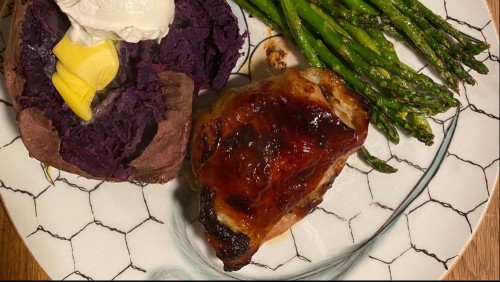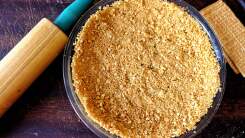Make a Dry Brine With Buttermilk Powder
I love soaking chicken in buttermilk. It is a truly unmatched marinade. The lactic acid tenderizes and flavors the meat, and the proteins accelerate browning, resulting in a beautifully bronzed, yet incredibly tender and juicy bird. The only drawback is that I tend to buy buttermilk intentionally, for specific uses, so I rarely have an excess of it in the fridge—but I do have powdered buttermilk in the pantry.
If you bake a lot, you have probably heard of powdered buttermilk: a dry, tangy, shelf-stable powder that can hang out in your pantry until you need it, allowing you to reconstitute the half cup or so you need for a recipe. It’s very convenient, and keeps me from having to dash to the store each time I need a small aliquot of the stuff for a baked good. But, as I discovered very recently, it also makes an excellent dry brine.
Rather than submerging meat in a vat of liquid buttermilk, you can mix the dry stuff with a little sugar and salt and sprinkle it on your protein. The mixture will draw moisture out of the meat, and that moisture will mix with the powdered buttermilk to form a concentrated marinade without any extra water.

I tried it with some chicken thighs this weekend, and it is a move I will be repeating. Those thighs were browned, succulent, and intensely flavorful. (Unfortunately, the only photographic evidence I have of these beautiful thighs is a single, garishly-lit iPhone photo, but you can still see the buttermilk powder’s handiwork quite clearly.)

Ratio-wise, you’ll need one tablespoon of sugar and one tablespoon of sea salt for every 1/4 cup of powdered buttermilk. (If all you have is iodized table salt, back it off to 2 teaspoons.) Mix the dry ingredients together, then dust the resulting mixture over whatever meat you wish to marinade, taking care not to let it get too thick or clumpy in any one spot, as that will block the moisture and keep your marinade from forming. I used about three tablespoons of the mixture for four bone-in, skin-on thighs. Once your meat is evenly dusted, toss it in a bag and let it hang out in the fridge for 24 hours, flipping the bag whenever you happen to remember to do so (two or three flips is plenty).
The next day, wipe off the excess liquid and cook your meat however you normally would. For these thighs, I just tossed them in a baking dish—without any extra fat or seasoning—and roasted them at 400℉ until they reached an internal temperature of 170℉, then brushed them with the pan juices just before serving. I ate two thighs in rapid succession, then a third, cold thigh while standing in the kitchen the next day. My boyfriend ate the fourth before I could get to it, but that’s okay—I can make more any time I want.
RECOMMENDED NEWS

You Should Brûlée All of Your Favorite Holiday Treats
Whether you’re huddling around a roaring campfire, grilling a sumptuous piece of meat, or brûlée-ing...

There's No Shame in a Cookie Crumb Crust
When I was in college, I got into baking as a way to mitigate the stress brought on by taking classe...

You Should Make Tiny Tomato Toast
Ever since I interviewed food journalist Alicia Kennedy about her daily eating habits, I have been ...

Make a Complete Breakfast for One in Your Air Fryer
Serving a good multi-component breakfast hinges on timing: The goal is to have everything on the pla...

This Four-Ingredient Onion Gravy Makes Any Dish Cozier
People love to talk about “sweater weather,” but—to me—the changing leaves and dropping temperatures...

The Best Method to Evenly Season Your Meat
Seasoning is obviously a very important part of cooking, second only to temperature control (and tha...
Comments on "Make a Dry Brine With Buttermilk Powder" :